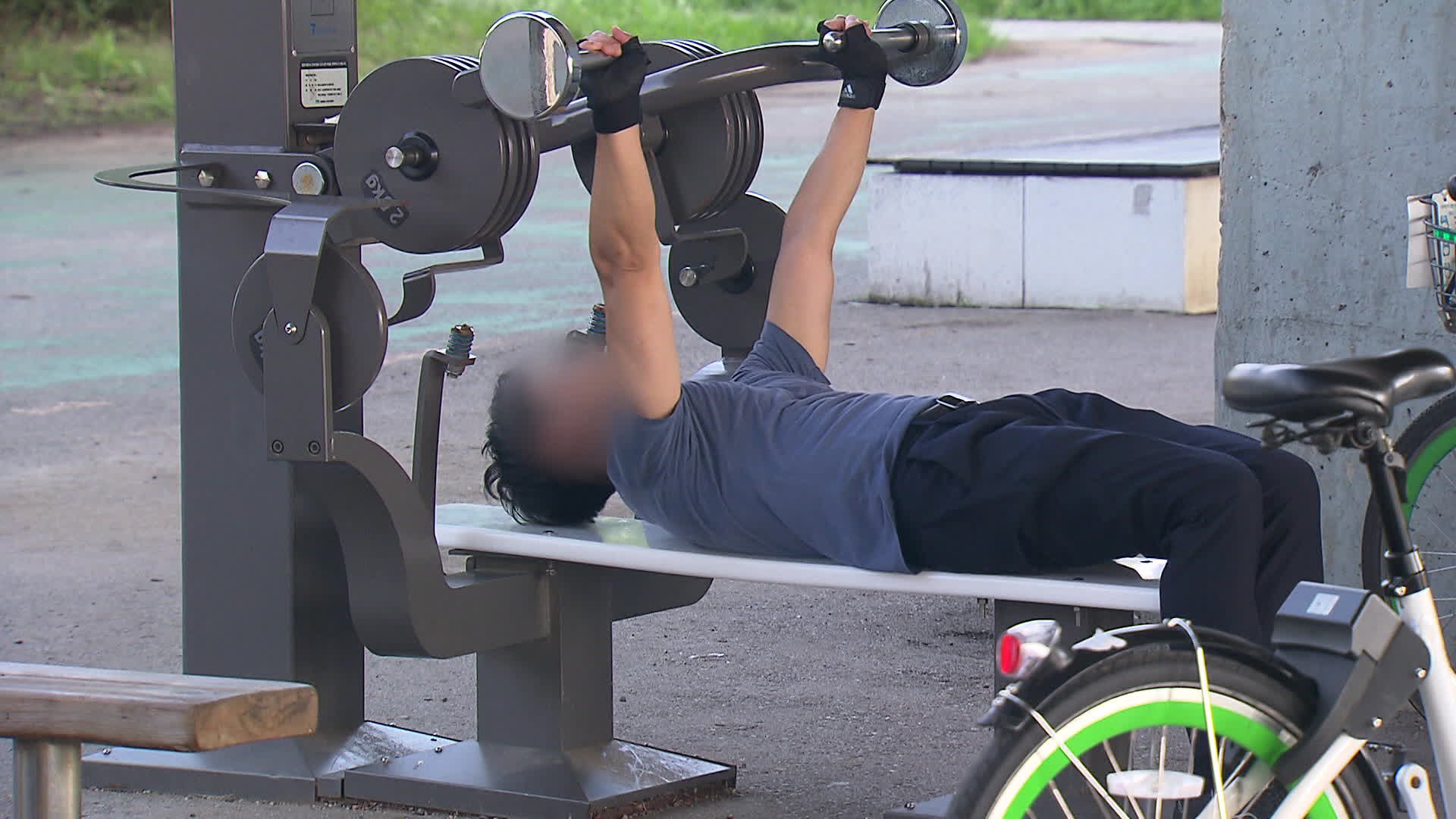[Anchor]
The shock of receiving a cancer diagnosis, followed by the effects of surgery and chemotherapy, makes even the smallest daily movements a significant burden for cancer patients.
Perhaps that is why many patients wonder if they should exercise in such conditions.
And the answer is yes, they definitely should.
However, there are some tips to follow.
Here’s medical correspondent Park Kwang-sik.
[Report]
A line dance class is in full swing that this cultural classroom in Seoul.
Park Yeon-soon steps in rhythm. She is a woman in her 60s who is now cancer-free after battling colon cancer.
She’s embraced various forms of exercises, from line dancing and yoga to walking 10,000 steps a day.
[Park Yeon-soon/Cancer Survivor: "I thought, let's just try it. I wanted to live each day joyfully and meaningfully, so I got involved in many activities. I didn't have time to dwell on negative thoughts."]
According to an analysis of over 215,000 cancer patients by the National Cancer Center, those who started exercising after a cancer diagnosis saw mortality rates drop by 13% for women and 18% for men.
Patients who engaged in moderate-intensity exercise had a 25% lower mortality rate compared to those who did not exercise, while those who engaged in high-intensity exercise had a 33% lower mortality rate.
The benefits of exercise were particularly pronounced in patients with stomach, colon, liver, lung, and prostate cancers.
[Yoo Ji-sung/Director of Rehabilitation Medicine, National Cancer Center: "Exercise can improve hormone metabolism related to cancer, enhance insulin resistance, or boost immune responses. These factors collectively contribute to improved cancer survival rates..."]
The American Cancer Society recommends that cancer survivors engage in at least 150 minutes of moderate-intensity aerobic exercise along with strength training at least twice a week.
However, the reality is different.
A survey of over 640 cancer survivors at Yonsei Cancer Hospital found that 7 to 8 out of 10 did not meet the recommended exercise levels.
[Breast Cancer Patient/Voice Altered: "After being diagnosed with cancer, I experienced depression about a year later. Honestly, I didn't exercise at all."]
Psychological factors, along with a decrease in muscle mass and stamina during cancer treatment, can lead to a vicious cycle of avoiding physical activity.
Many patients believe that simply walking for a long time, like taking a stroll, is sufficient exercise.
However, experts advise that increasing exercise intensity to the point of breathlessness is necessary to improve outcomes for cancer patients.
[Park Ji-soo/Director of Cancer Prevention Center, Yonsei Cancer Hospital: "There is not much data showing that very low-intensity exercise offers significant benefits. So, when possible, engaging in moderate- or higher-intensity exercise is more effective in preventing cancer and its recurrence..."]
It is important to gradually increase the amount of exercise based on the patient's fitness level.
Walking briskly for 30 minutes a day and doing light strength training with resistance bands or dumbbells twice a week can make a real difference in a cancer patient’s prognosis.
This is KBS News, Park Kwang-sik.
The shock of receiving a cancer diagnosis, followed by the effects of surgery and chemotherapy, makes even the smallest daily movements a significant burden for cancer patients.
Perhaps that is why many patients wonder if they should exercise in such conditions.
And the answer is yes, they definitely should.
However, there are some tips to follow.
Here’s medical correspondent Park Kwang-sik.
[Report]
A line dance class is in full swing that this cultural classroom in Seoul.
Park Yeon-soon steps in rhythm. She is a woman in her 60s who is now cancer-free after battling colon cancer.
She’s embraced various forms of exercises, from line dancing and yoga to walking 10,000 steps a day.
[Park Yeon-soon/Cancer Survivor: "I thought, let's just try it. I wanted to live each day joyfully and meaningfully, so I got involved in many activities. I didn't have time to dwell on negative thoughts."]
According to an analysis of over 215,000 cancer patients by the National Cancer Center, those who started exercising after a cancer diagnosis saw mortality rates drop by 13% for women and 18% for men.
Patients who engaged in moderate-intensity exercise had a 25% lower mortality rate compared to those who did not exercise, while those who engaged in high-intensity exercise had a 33% lower mortality rate.
The benefits of exercise were particularly pronounced in patients with stomach, colon, liver, lung, and prostate cancers.
[Yoo Ji-sung/Director of Rehabilitation Medicine, National Cancer Center: "Exercise can improve hormone metabolism related to cancer, enhance insulin resistance, or boost immune responses. These factors collectively contribute to improved cancer survival rates..."]
The American Cancer Society recommends that cancer survivors engage in at least 150 minutes of moderate-intensity aerobic exercise along with strength training at least twice a week.
However, the reality is different.
A survey of over 640 cancer survivors at Yonsei Cancer Hospital found that 7 to 8 out of 10 did not meet the recommended exercise levels.
[Breast Cancer Patient/Voice Altered: "After being diagnosed with cancer, I experienced depression about a year later. Honestly, I didn't exercise at all."]
Psychological factors, along with a decrease in muscle mass and stamina during cancer treatment, can lead to a vicious cycle of avoiding physical activity.
Many patients believe that simply walking for a long time, like taking a stroll, is sufficient exercise.
However, experts advise that increasing exercise intensity to the point of breathlessness is necessary to improve outcomes for cancer patients.
[Park Ji-soo/Director of Cancer Prevention Center, Yonsei Cancer Hospital: "There is not much data showing that very low-intensity exercise offers significant benefits. So, when possible, engaging in moderate- or higher-intensity exercise is more effective in preventing cancer and its recurrence..."]
It is important to gradually increase the amount of exercise based on the patient's fitness level.
Walking briskly for 30 minutes a day and doing light strength training with resistance bands or dumbbells twice a week can make a real difference in a cancer patient’s prognosis.
This is KBS News, Park Kwang-sik.
■ 제보하기
▷ 카카오톡 : 'KBS제보' 검색, 채널 추가
▷ 전화 : 02-781-1234, 4444
▷ 이메일 : kbs1234@kbs.co.kr
▷ 유튜브, 네이버, 카카오에서도 KBS뉴스를 구독해주세요!
- Exercise key for cancer survival
-
- 입력 2025-08-24 01:49:56

[Anchor]
The shock of receiving a cancer diagnosis, followed by the effects of surgery and chemotherapy, makes even the smallest daily movements a significant burden for cancer patients.
Perhaps that is why many patients wonder if they should exercise in such conditions.
And the answer is yes, they definitely should.
However, there are some tips to follow.
Here’s medical correspondent Park Kwang-sik.
[Report]
A line dance class is in full swing that this cultural classroom in Seoul.
Park Yeon-soon steps in rhythm. She is a woman in her 60s who is now cancer-free after battling colon cancer.
She’s embraced various forms of exercises, from line dancing and yoga to walking 10,000 steps a day.
[Park Yeon-soon/Cancer Survivor: "I thought, let's just try it. I wanted to live each day joyfully and meaningfully, so I got involved in many activities. I didn't have time to dwell on negative thoughts."]
According to an analysis of over 215,000 cancer patients by the National Cancer Center, those who started exercising after a cancer diagnosis saw mortality rates drop by 13% for women and 18% for men.
Patients who engaged in moderate-intensity exercise had a 25% lower mortality rate compared to those who did not exercise, while those who engaged in high-intensity exercise had a 33% lower mortality rate.
The benefits of exercise were particularly pronounced in patients with stomach, colon, liver, lung, and prostate cancers.
[Yoo Ji-sung/Director of Rehabilitation Medicine, National Cancer Center: "Exercise can improve hormone metabolism related to cancer, enhance insulin resistance, or boost immune responses. These factors collectively contribute to improved cancer survival rates..."]
The American Cancer Society recommends that cancer survivors engage in at least 150 minutes of moderate-intensity aerobic exercise along with strength training at least twice a week.
However, the reality is different.
A survey of over 640 cancer survivors at Yonsei Cancer Hospital found that 7 to 8 out of 10 did not meet the recommended exercise levels.
[Breast Cancer Patient/Voice Altered: "After being diagnosed with cancer, I experienced depression about a year later. Honestly, I didn't exercise at all."]
Psychological factors, along with a decrease in muscle mass and stamina during cancer treatment, can lead to a vicious cycle of avoiding physical activity.
Many patients believe that simply walking for a long time, like taking a stroll, is sufficient exercise.
However, experts advise that increasing exercise intensity to the point of breathlessness is necessary to improve outcomes for cancer patients.
[Park Ji-soo/Director of Cancer Prevention Center, Yonsei Cancer Hospital: "There is not much data showing that very low-intensity exercise offers significant benefits. So, when possible, engaging in moderate- or higher-intensity exercise is more effective in preventing cancer and its recurrence..."]
It is important to gradually increase the amount of exercise based on the patient's fitness level.
Walking briskly for 30 minutes a day and doing light strength training with resistance bands or dumbbells twice a week can make a real difference in a cancer patient’s prognosis.
This is KBS News, Park Kwang-sik.
The shock of receiving a cancer diagnosis, followed by the effects of surgery and chemotherapy, makes even the smallest daily movements a significant burden for cancer patients.
Perhaps that is why many patients wonder if they should exercise in such conditions.
And the answer is yes, they definitely should.
However, there are some tips to follow.
Here’s medical correspondent Park Kwang-sik.
[Report]
A line dance class is in full swing that this cultural classroom in Seoul.
Park Yeon-soon steps in rhythm. She is a woman in her 60s who is now cancer-free after battling colon cancer.
She’s embraced various forms of exercises, from line dancing and yoga to walking 10,000 steps a day.
[Park Yeon-soon/Cancer Survivor: "I thought, let's just try it. I wanted to live each day joyfully and meaningfully, so I got involved in many activities. I didn't have time to dwell on negative thoughts."]
According to an analysis of over 215,000 cancer patients by the National Cancer Center, those who started exercising after a cancer diagnosis saw mortality rates drop by 13% for women and 18% for men.
Patients who engaged in moderate-intensity exercise had a 25% lower mortality rate compared to those who did not exercise, while those who engaged in high-intensity exercise had a 33% lower mortality rate.
The benefits of exercise were particularly pronounced in patients with stomach, colon, liver, lung, and prostate cancers.
[Yoo Ji-sung/Director of Rehabilitation Medicine, National Cancer Center: "Exercise can improve hormone metabolism related to cancer, enhance insulin resistance, or boost immune responses. These factors collectively contribute to improved cancer survival rates..."]
The American Cancer Society recommends that cancer survivors engage in at least 150 minutes of moderate-intensity aerobic exercise along with strength training at least twice a week.
However, the reality is different.
A survey of over 640 cancer survivors at Yonsei Cancer Hospital found that 7 to 8 out of 10 did not meet the recommended exercise levels.
[Breast Cancer Patient/Voice Altered: "After being diagnosed with cancer, I experienced depression about a year later. Honestly, I didn't exercise at all."]
Psychological factors, along with a decrease in muscle mass and stamina during cancer treatment, can lead to a vicious cycle of avoiding physical activity.
Many patients believe that simply walking for a long time, like taking a stroll, is sufficient exercise.
However, experts advise that increasing exercise intensity to the point of breathlessness is necessary to improve outcomes for cancer patients.
[Park Ji-soo/Director of Cancer Prevention Center, Yonsei Cancer Hospital: "There is not much data showing that very low-intensity exercise offers significant benefits. So, when possible, engaging in moderate- or higher-intensity exercise is more effective in preventing cancer and its recurrence..."]
It is important to gradually increase the amount of exercise based on the patient's fitness level.
Walking briskly for 30 minutes a day and doing light strength training with resistance bands or dumbbells twice a week can make a real difference in a cancer patient’s prognosis.
This is KBS News, Park Kwang-sik.
-
-

박광식 기자 doctor@kbs.co.kr
박광식 기자의 기사 모음
-
이 기사가 좋으셨다면
-
좋아요
0
-
응원해요
0
-
후속 원해요
0















이 기사에 대한 의견을 남겨주세요.